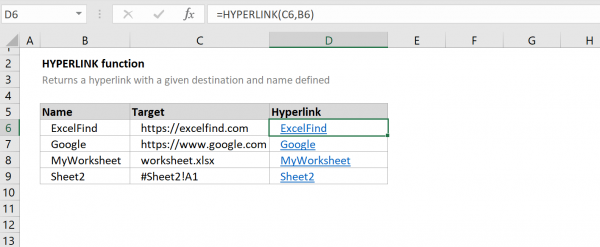5 Easy Steps to Hyperlink Between Excel Sheets

Hyperlinking between Excel sheets isn't just about convenience; it's about transforming your data management into a seamless experience. Whether you're working on a complex financial model, organizing a project database, or simply compiling a report, Excel's hyperlink feature lets you navigate through extensive datasets with ease. Here, we'll guide you through five simple steps to link your Excel sheets, making data navigation as smooth as silk.
Step 1: Understanding Your Spreadsheet Layout

Before diving into hyperlinks, it’s essential to know your spreadsheet’s structure. Here are a few points to consider:
- Map out your data: Identify how your spreadsheets are interconnected.
- Naming sheets: Use descriptive names to make navigation intuitive.
- Table of Contents: Consider creating a summary sheet that provides an overview of all your sheets.
📢 Note: A clear layout reduces the complexity of linking and enhances overall document usability.
Step 2: Creating a Hyperlink to Another Sheet

Now, let’s get into the mechanics of creating hyperlinks:
- Select the cell or text where you want to place the hyperlink.
- Go to the Insert tab in the ribbon.
- Click on Hyperlink or use the shortcut Ctrl+K.
- In the dialog box that appears:
- In the ‘Link to’ section, select ‘Place in This Document’.
- From the list, choose the sheet you want to link to.
- Optionally, type a text to appear as the link label in the ‘Display text’ field.
- Click OK to create the hyperlink.
📂 Note: If your spreadsheet contains many sheets, use the search function in the dialog box to find the sheet quickly.

Step 3: Linking to a Specific Cell or Range

Linking directly to a cell or range is a game-changer for precision:
- Select the cell or text to hyperlink from.
- Open the Insert Hyperlink dialog.
- In the ‘Place in this document’ section:
- Select the sheet.
- Type the cell reference (e.g., ‘A1’ or ‘Table1[Column1]’) in the ‘Type the cell reference’ field.
- If linking to a range, enter it in the format ‘A1:C3’.
- Set the display text and click OK.
🔍 Note: When linking to a table, ensure that the table has a unique name for accurate referencing.
Step 4: Managing and Organizing Hyperlinks

Over time, your spreadsheet might grow, and managing hyperlinks can become tedious. Here’s how to stay organized:
- Create a Hyperlink Index: Keep a sheet dedicated to listing all hyperlinks for quick reference.
- Color Code Hyperlinks: Use different colors to indicate the type of link (e.g., internal vs. external).
- Update Hyperlinks: If sheet names or cell references change, update your hyperlinks accordingly.
🔎 Note: Periodic review of hyperlinks is crucial for maintaining document integrity.
| Hyperlink Type | Description | Color Code |
|---|---|---|
| Internal | Links within the same workbook | Blue |
| External | Links to other Excel files or web pages | Purple |

Step 5: Troubleshooting Common Issues

Sometimes, things don’t go as planned. Here are some common issues and their solutions:
- Broken Hyperlinks: If you rename or delete a sheet, hyperlinks to it will break. Use Excel’s Check for Issues under File > Info to identify broken links.
- Incorrect Cell References: Double-check the cell or range references to ensure accuracy. Use named ranges for stability.
- Hyperlinks not Opening: Ensure that the destination workbook is open or accessible if linking to another workbook.
- Hyperlink Navigation not Working: Make sure you’re using the correct method to open links; try using Shift + F5 to navigate to hyperlinks.
⚠️ Note: Always keep backups of your Excel files, especially before renaming or deleting sheets with active hyperlinks.
Summing up this guide, mastering the art of hyperlinking between Excel sheets can dramatically streamline your data management. It allows you to jump from summary data to detailed analyses with a click, reduces clutter by minimizing repeated information, and significantly boosts productivity. Just remember to organize your sheets logically, ensure your hyperlinks are accurate, and keep an eye on your hyperlinks’ health for a smooth and efficient experience with your spreadsheets.
Why don’t my hyperlinks in Excel work anymore?

+
Your hyperlinks might not work due to several reasons: the linked sheet or cell might have been renamed or deleted, or the workbook containing the link might be closed or inaccessible. Check for these common issues and update or repair your hyperlinks as needed.
Can I link to a specific range in another Excel file?

+
Yes, you can link to a specific cell or range in another Excel file by selecting ‘Place in this document’ in the Hyperlink dialog, then entering the workbook, sheet, and cell reference or named range.
How do I create a table of contents in Excel?

+
Creating a table of contents can be done by listing your sheets in a dedicated sheet and using hyperlinks to each sheet. Name your sheets descriptively, and use these names in your TOC to make navigation easier.